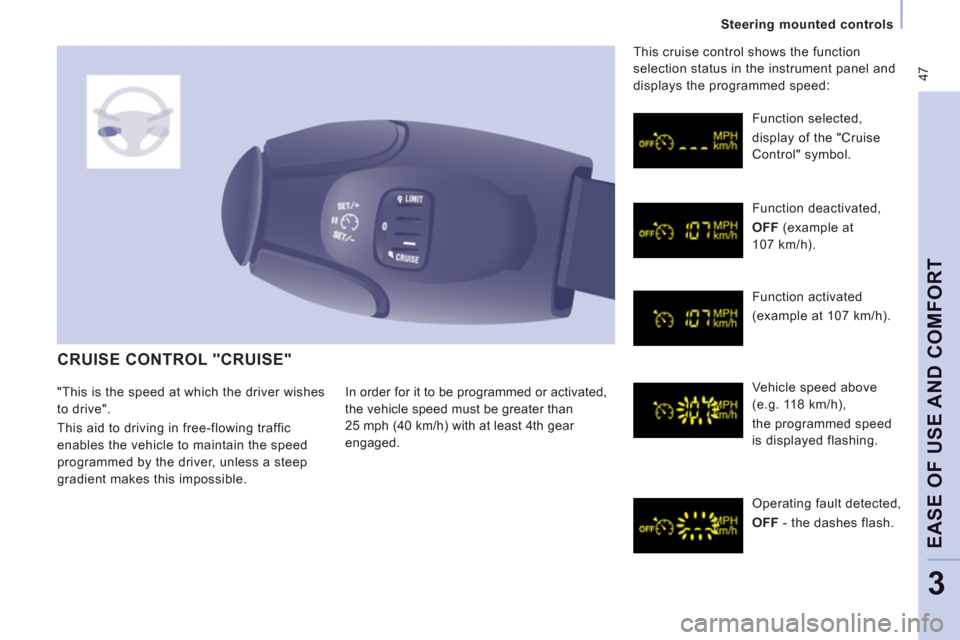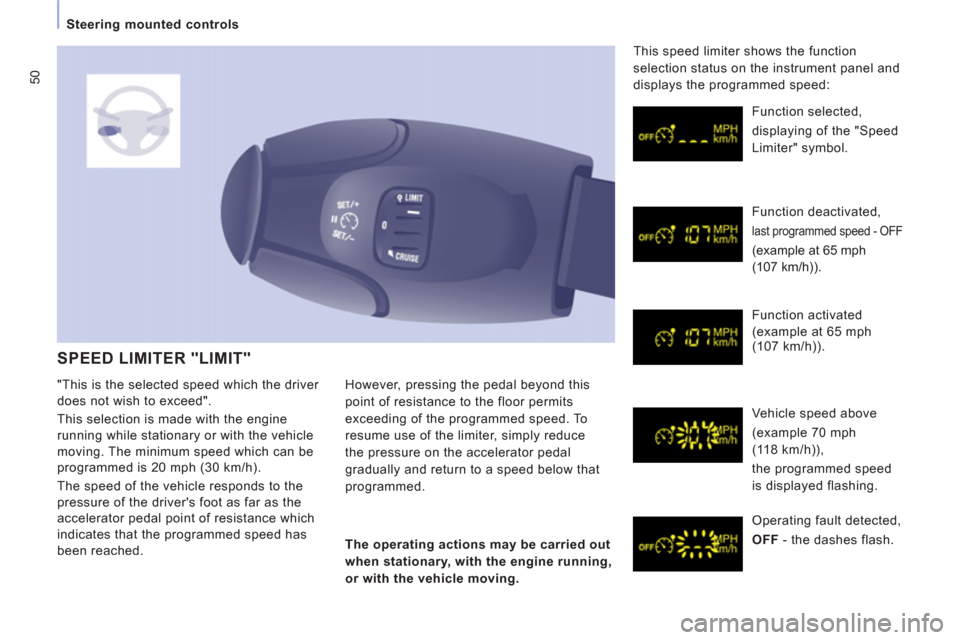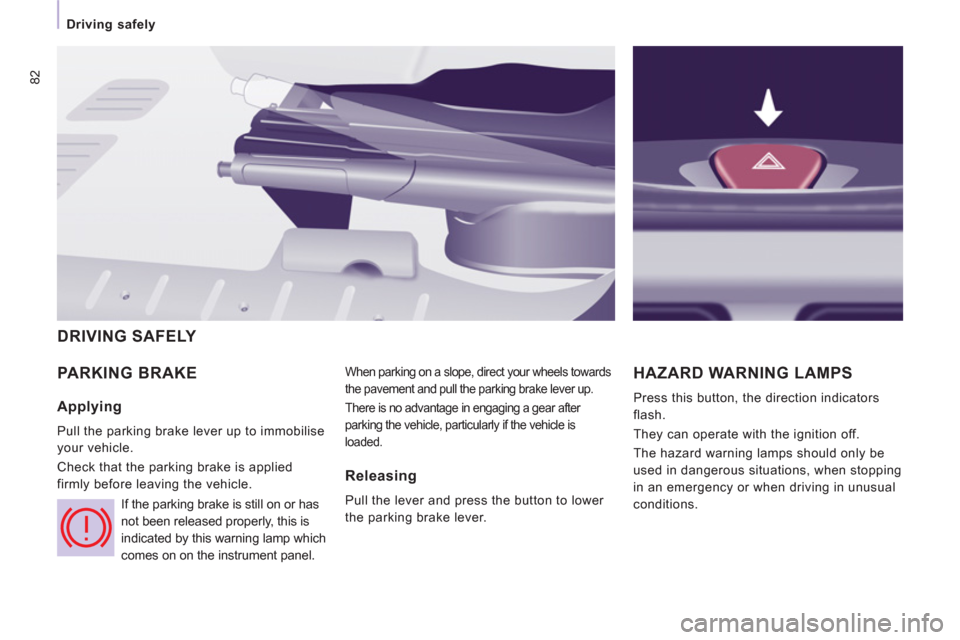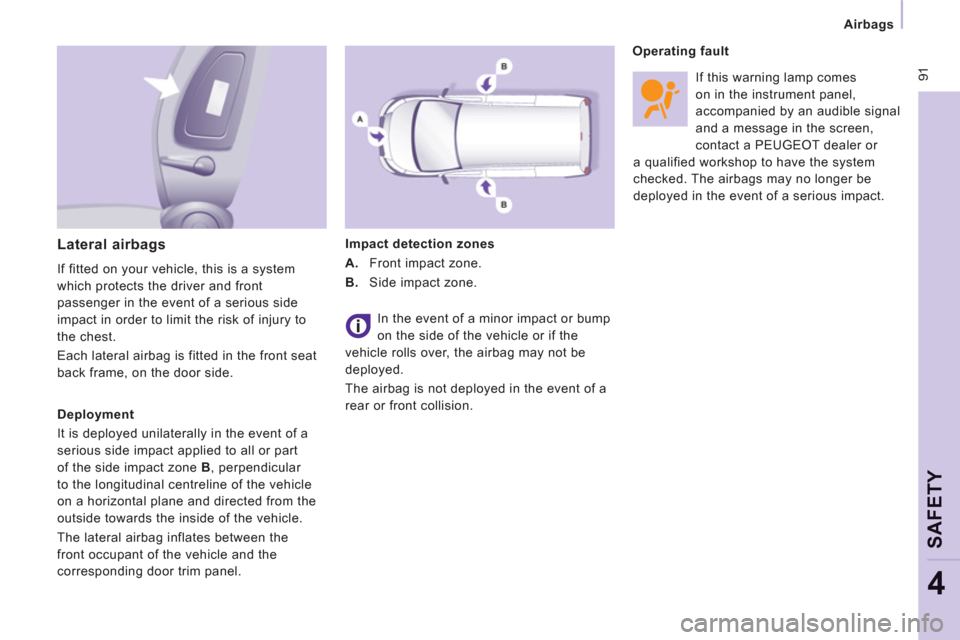2011 Peugeot Expert VU instrument panel
[x] Cancel search: instrument panelPage 44 of 260

42
Steering mounted controls
Dipped beam/main beam change
Pull the stalk full
y towards you.
Automatic lights
if
your vehicle is fitted with
a
brightness sensor. Li
ghts off
Dipped beam
(green)
Main beam (blue)
DIRECTION INDICATORS (flashing)
STEERING MOUNTED CONTROLS
Checking by means of the indicator lights on the instrument panel isdescribed in the "Instruments andcontrols" section of chapter 2.
Side lights
Lights-on buzzer
When the ignition is switched o
ff, when the
driver's door is o
pened, a buzzer sounds if
you have left your lights on.
Left: downwards passing
the point o
f resistance.
Right: upwards passing
the point o
f resistance.
LIGHTING CONTROL
Front and rear lights
Selection is by turning ring A.
Page 45 of 260

43
Steering mounted controls
EASE OF USE AND COMFOR
T
3
Front fog lights (green)
and rear fo
g lights (amber,
2nd rotation o
f the ring
forwards).
To switch o
ff the front and rear fog
lights, turn the ring rearwards twice in
succession.
In clear weather or in rain, both day
and night, rear fog lights dazzle and
are prohibited.
Do not for
get to switch them off when they
are no longer needed.
Automatic switchin
g on of the lights switches
o
ff the rear fog lamps, but the front fog
lamps remain on.
Daytime lights
Depending on the country in which the
vehicle is sold, the vehicle ma
y be equipped
w
ith daytime lights. The dipped headlamps
come on when the vehicle is started.
Th
e instruments and controls
(instrument panel, display, air
conditioning control panel, ...) are only lit
on switchin
g to the automatic switching on
of the li
ghts mode or when the lights are
switched on manually.
Front and rear fog lights
Rotate ring Bforwards to switch on and
rearwards to switch off. The status is
confirmed by the light on the instrument
panel.
These operate with the side lights and the
di
pped beam headlamps.
Front
fog lights (green, 1st
rotation of the ring forwards).
This warning light comes on on
the instrument panel.
Page 49 of 260

47
Steering mounted controls
EASE OF USE AND COMFOR
T
3
CRUISE CONTROL "CRUISE"
In order for it to be programmed or activated,
the vehicle speed must be
greater than
25 mph
(40 km/h) with at least 4th gear
en
gaged. Function selected,
displa
y of the "Cruise
Control" s
ymbol.
Function deactivated,
OFF
(example at
107 km/h
).
F
unction activated
(example at 107 km/h).
Vehicle speed above
(e.g. 118 km/h),
the pro
grammed speed
is displa
yed flashing.
Operating fault detected,
OFF
- th
e dashes flash. Thi
s cruise control shows the function
selection status in the instrument panel and
displays the programmed speed:
"This is the speed at which the driver wishes
t
o drive".
This aid to drivin
g in free-flowing traffic
enables the vehicle to maintain the speed
programmed by the driver, unless a steep
gradient makes this impossible.
Page 52 of 260

50
Steering mounted controls
SPEED LIMITER "LIMIT"
However, pressing the pedal beyond this
point of resistance to the floor permits
exceedin
g of the programmed speed. To
resume use o
f the limiter, simply reduce
the
pressure on the accelerator pedal
gradually and return to a speed below that
programmed.
Function selected,
displa
ying of the "Speed
Limiter" s
ymbol.
Function deactivated,
last programmed speed - OFF
(example at 65 mph
(107 km/h)).
F
unction activated
(example at 65 mph(107 km/h)).
Vehicle speed above
(example 70 mph
(118 km/h)),
t
he programmed speed
is displayed flashing.
Operating fault detected,
OFF- th
e dashes flash. This speed limiter shows the
function
selection status on the instrument panel and
displays the programmed speed:
The operating actions may be carried out
w
hen stationary, with the engine running,
or with the vehicle movin
g.
"This is the selected speed which the driver does not wish to exceed".
This selection is made with the en
gine running while stationary or with the vehicle moving. The minimum speed which can beprogrammed is 20 mph (30 km/h).
The s
peed of the vehicle responds to the pressure of the driver's foot as far as the
accelerator pedal point of resistance which
indicates that the programmed speed has
been reached.
Page 78 of 260

76
Rear suspension
Metal suspension
This equipment adopts long movement limiters
which make it possible to
guarantee stable
behaviour both when loaded and when empt
y.
No action on your part is required except to
ensure that maintenance is carried out and that
the authorised loads are com
plied with.irrespective o
f the weight of the load, within
the limit of the authorised values.
On board,
the increasin
g or lightening of the load on
the vehicle's plat
form is detected by two
hei
ght sensors. When all of the doors are
closed, the sensors trigger the automatic
hei
ght correction and determine the optimum
hei
ght of the sill for the vehicle's driving
conditions.
Deactivation of automatic height correction
The control which permits deactivation o
f
automatic re
gulation is located on the right-
hand side, at the rear of the vehicle.
REAR SUSPENSION
You must deactivate automatic height
correction manually in the following
situations:
- when working underneath the vehicle,
- when changing a wheel,
- when the vehicle is being transported by
lorry, train, ferry, boat, ...
Two t
ypes of suspension are available.
Rear suspension with pneumatic height correction
If fitted on your vehicle, this type of
suspension regulates the variations in the
height of the rear platform of your vehicle
1.
Automatic height
correction
2.
Manual height
correction
1 - Automatic correction of the
height of the rear sill
The pneumatic suspension automatically
re
gulates the variations in the height of the
rear plat
form of your vehicle.
A red warning light on your
instrument panel
fl ashes if the
height is not at its optimum level
and requires correction, drive slowl
y
until this warning lamp goes off.
The automatic hei
ght correction is
temporar
ily inactive:
- if a door/the tailgate is open,
- when braking or when stopped at a red
traffic signal (brake pedal pressed).
With the vehicle stationary:
- press and hold,
- release the control.
Deactivation is confirmed b
y
th
e LED which is on. It remains on for
approximately
30 seconds.
Return to automatic correction
With the vehicle stationary:
- press and hold,
- release the control.
Return to automatic hei
ght correction
is confi rmed b
y the LED which goes off.
According to the configurations, a bleep may
be heard durin
g these operations.
Two functions
Page 84 of 260

82
Driving safely
PARKING BRAKE
When parking on a slope, direct your wheels towards
the pavement and pull the parking brake lever up.
There is no advantage in engaging a gear after
parking the vehicle, particularly if the vehicle is
loaded.
HAZARD WARNING LAMPS
Press this button, the direction indicators
flash.
They can operate with the ignition off.
The hazard warning lamps should only be
used in dangerous situations, when stopping
in an emergency or when driving in unusual
conditions.
DRIVING SAFELY
Applying
Pull the parking brake lever up to immobilise
your vehicle.
Check that the parking brake is applied
firmly before leaving the vehicle.
If the parking brake is still on or has
not been released properly, this is
indicated by this warning lamp which
comes on on the instrument panel.
Releasing
Pull the lever and press the button to lower
the parking brake lever.
Page 93 of 260

91
Airbags
SAFETY
4
If this warning lamp comes
on in the instrument panel,
accompanied by an audible signal
and a message in the screen,
contact a PEUGEOT dealer or
a qualified workshop to have the system
checked. The airbags may no longer be
deployed in the event of a serious impact.
Lateral airbags
If fitted on your vehicle, this is a system
which protects the driver and front
passenger in the event of a serious side
impact in order to limit the risk of injury to
the chest.
Each lateral airbag is fitted in the front seat
back frame, on the door side.
Impact detection zones
A.
Front impact zone.
B.
Side impact zone.
In the event of a minor impact or bump
on the side of the vehicle or if the
vehicle rolls over, the airbag may not be
deployed.
The airbag is not deployed in the event of a
rear or front collision.
Operating fault
Deployment
It is deployed unilaterally in the event of a
serious side impact applied to all or part
of the side impact zone B
, perpendicular
to the longitudinal centreline of the vehicle
on a horizontal plane and directed from the
outside towards the inside of the vehicle.
The lateral airbag inflates between the
front occupant of the vehicle and the
corresponding door trim panel.
Page 94 of 260

92
Airbags
Deactivating
The passenger's front airbag alone can be
deactivated:
- With the ignition switched off
, insert
the key into the passenger's airbag
deactivation switch,
- turn it to the "OFF"
position,
- then remove the key keeping the switch
in the new position.
Front airbags
The front airbags are fitted in the centre of
the steering wheel for the driver and in the
dashboard for the front passenger.
Reactivation
In the "OFF"
position, the passenger's
airbag will not be deployed in the event of
an impact.
As soon as the child seat is removed, turn
the airbag switch to the "ON"
position to
reactivate the airbag and thus ensure the
safety of your passenger in the event of an
impact. To ensure the safety of your child, it is
essential to deactivate the passengers
airbag when you install a rear-facing child
seat on the front passenger seat. Otherwise,
the child would risk being killed or seriously
injured if the airbag were to inflate.
The airbag warning lamp in the
instrument panel is on while the
airbag is deactivated.
Deployment
They are deployed simultaneously, unless
the passenger's front airbag has been
deactivated, in the event of a serious front
impact applied to all or part of the front
impact zone A
in the longitudinal centreline
of the vehicle on a horizontal plane directed
from the front towards the rear of the
vehicle.
The front airbag inflates between the front
occupant of the vehicle and the dashboard
to cushion their forward movement.
If this warning lamp comes on,
accompanied by an audible signal
and a message in the screen,
contact a PEUGEOT dealer or a
qualified workshop to have the
system checked.
Front airbag fault
If the two airbag warning lamps are
on continuously, do not install a rear-
facing child seat. Contact a PEUGEOT or a
qualified workshop.